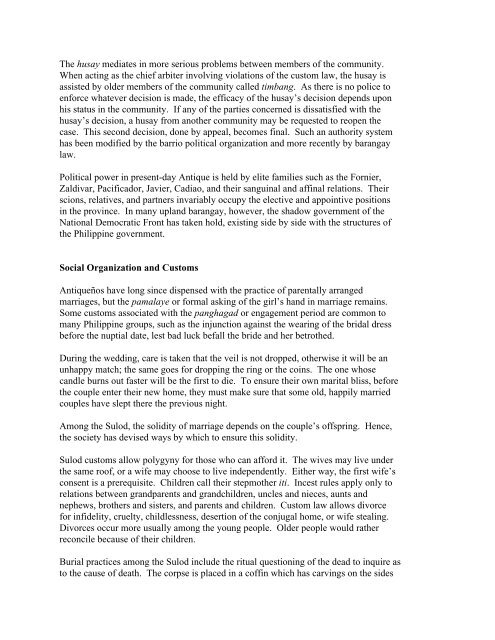Kinaray-a
Kinaray-a
Kinaray-a
Create successful ePaper yourself
Turn your PDF publications into a flip-book with our unique Google optimized e-Paper software.
The husay mediates in more serious problems between members of the community.<br />
When acting as the chief arbiter involving violations of the custom law, the husay is<br />
assisted by older members of the community called timbang. As there is no police to<br />
enforce whatever decision is made, the efficacy of the husay’s decision depends upon<br />
his status in the community. If any of the parties concerned is dissatisfied with the<br />
husay’s decision, a husay from another community may be requested to reopen the<br />
case. This second decision, done by appeal, becomes final. Such an authority system<br />
has been modified by the barrio political organization and more recently by barangay<br />
law.<br />
Political power in present-day Antique is held by elite families such as the Fornier,<br />
Zaldivar, Pacificador, Javier, Cadiao, and their sanguinal and affinal relations. Their<br />
scions, relatives, and partners invariably occupy the elective and appointive positions<br />
in the province. In many upland barangay, however, the shadow government of the<br />
National Democratic Front has taken hold, existing side by side with the structures of<br />
the Philippine government.<br />
Social Organization and Customs<br />
Antiqueños have long since dispensed with the practice of parentally arranged<br />
marriages, but the pamalaye or formal asking of the girl’s hand in marriage remains.<br />
Some customs associated with the panghagad or engagement period are common to<br />
many Philippine groups, such as the injunction against the wearing of the bridal dress<br />
before the nuptial date, lest bad luck befall the bride and her betrothed.<br />
During the wedding, care is taken that the veil is not dropped, otherwise it will be an<br />
unhappy match; the same goes for dropping the ring or the coins. The one whose<br />
candle burns out faster will be the first to die. To ensure their own marital bliss, before<br />
the couple enter their new home, they must make sure that some old, happily married<br />
couples have slept there the previous night.<br />
Among the Sulod, the solidity of marriage depends on the couple’s offspring. Hence,<br />
the society has devised ways by which to ensure this solidity.<br />
Sulod customs allow polygyny for those who can afford it. The wives may live under<br />
the same roof, or a wife may choose to live independently. Either way, the first wife’s<br />
consent is a prerequisite. Children call their stepmother iti. Incest rules apply only to<br />
relations between grandparents and grandchildren, uncles and nieces, aunts and<br />
nephews, brothers and sisters, and parents and children. Custom law allows divorce<br />
for infidelity, cruelty, childlessness, desertion of the conjugal home, or wife stealing.<br />
Divorces occur more usually among the young people. Older people would rather<br />
reconcile because of their children.<br />
Burial practices among the Sulod include the ritual questioning of the dead to inquire as<br />
to the cause of death. The corpse is placed in a coffin which has carvings on the sides
















